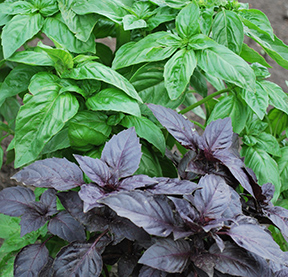Growing basil in your backyard
Brittnay Haag, horticulture educator, Illinois Extension — July 12, 2020
Depending on rainfall and temperatures, plan to water basil at least once a week, and more often when it’s hot. (Photo courtesy of Extension Services)
Nothing says summer like enjoying freshly harvested herbs from your garden or patio.
“One of the easiest, most prolific, and flavorful herbs to grow is basil,” said Brittnay Haag, University of Illinois Extension horticulture educator.
While there are many cultivars of basil, Ocimum basilicum, the most common are sweet basil and Genovese basil. Basil grows best in sunny locations with 6 to 8 hours of sun each day, and well-drained, fertile soil. It can also grow well in containers or raised beds that have adequate drainage. Some varieties of basil have showy blooms, if you’re growing it for ornamental value and not culinary purposes, including some of the purple-leafed varieties with small pink blooms on a spike.
Planting
Basil is cold sensitive so it must be planted outdoors after the chance of frost has passed. When planting basil, proper spacing is crucial to provide good air circulation between the plants and decrease the likelihood of disease. Space plants at least two feet apart. Basil can also be directly seeded in the garden after the threat of spring frost has passed.
Care
Apply two to three inches of mulch around the base of basil to retain water moisture and reduce weeds. Water regularly to guarantee good growth and development. Water at the base of the plant or use drip-irrigation, or drip hoses to ensure the foliage stays dry.
Depending on rainfall and temperatures, plan to water basil at least once a week, and more often when it’s hot. Plants grown in containers will dry out faster. Plants that are overwatered or underwatered may develop weak, spindly growth or roots may rot.
“Basil is a tender annual and will not survive Illinois winters outside,” Haag said. “But dig up your plants before the first freeze and bring them inside and you can extend their growing season by a couple of months.”
Fertilizer
If plant growth is reduced and the foliage has become a paler green color, basil can be fertilized every three to four weeks with a liquid fertilizer, following directions on the manufacturer label. Over-fertilizing herbs can result in decreased aroma and taste, so don’t overdo it.
Harvesting
An important task when growing basil for culinary uses is to keep the plant from blooming. If it flowers and develops seeds, the plant will become woody, stop producing and the foliage will become bitter tasting. Continue to remove blooms all season.
When harvesting the foliage, cut the whole stem just above a pair of leaves, leaving at least half of the plants. New growth will appear at the cut point within a week. Individual leaves can also be harvested. Freshly harvested basil stores best for a few days in a vase of water at room temperature.
“During peak basil season, you may have more than you know what do with,” Haag said. “Try preserving them by drying or freezing leaves.”
To dry basil leaves on the stem, hang the foliage upside down in small bundles in a warm, well-ventilated room for one week. Strip off dry leaves and store them whole or ground up in an air-tight container. For a fresher flavor, freeze basil leaves whole in plastics bags or chopped into small pieces in an ice-cube tray with some water.
Pests and Diseases
While pests and diseases are not always a problem with basil, some common issues to watch out for are gray mold, leaf spots, and Japanese beetles. Watering at the base of the plant and not the foliage reduces occurrences of gray mold and leaf spot. Japanese beetles can skeletonize. They should be hand-picked from the plants and dropped in a bucket of soapy water. Plants can also be covered with a light-weight row cover to protect the foliage from the beetles.
For more information about growing and using herbs, visit the Illinois Extension herb website at extension.illinois.edu/herbs.
Brittnay Haag, horticulture educator, Illinois Extension







